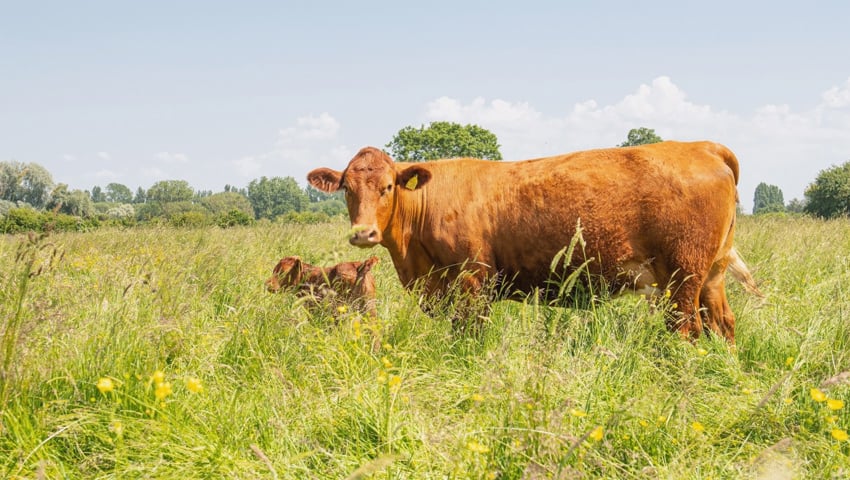Article by Øistein Thorsen, Chief Executive, FAI Farms.
In a recent Guardian article George Monbiot acknowledges that feeding the world sustainably is a complex challenge. He then accuses FAI’s recent report about the Adaptive Multi-Paddock (AMP) grazing project, sponsored by McDonald’s, of “trying to sell … a bucolic fairytale.”
The full report describes the 55 environmental, ethical and economic metrics measured during the four-year transition process to regenerative farming on our farm in Oxford. Monbiot’s critique ignored 54 of them.
Instead of reviewing the many complex impact metrics we documented, he chose to challenge the robustness of the data related to one metric; the project’s carbon balance, which was calculated to be beyond net zero (-49.7t of CO₂e).
This result was due to relatively low emissions and modelled carbon sequestration in our permanent pastures.
On the multiple dimensions of biodiversity, water holding capacity, animal welfare and farmer resilience, the totality of our lived, observed and measured experience was dismissed as “a right old mess, without a single usable data point”.
In fact, our report states clearly what our methodology was, which data points we used, what limitations we faced and what the findings tell us. The spirit and tone of our report is not meat industry propaganda “seeking to sow confusion”, but rather it’s a call for collaboration to strengthen the science of regenerative agriculture.
Regenerative grazing is a grassroots movement led by brave, entrepreneurial and innovative farmers who are changing the way they farm inspired by ruminant animals’ role in creating and upholding healthy grass-based ecosystems all over the world.
Grasslands occupy 26 per cent of the global land area and approximately two-thirds of agricultural land (using FAO’s grassland definition; Ritchie & Roser, 2019) and the carbon stored as soil organic carbon under grasslands amounts to 20 per cent of global carbon stocks (Whitehead, 2020).
Our carbon balance assessment was based on modelling using the Sandy Natural Capital Navigator platform from Trinity AgTech.
All carbon calculators use models which aim to codify a set of interconnected, complex biological systems. Sandy uses the most up to date, scientifically robust carbon accounting methodologies available. It is compliant with national and international standards and frameworks for carbon accounting and has been recognised by Defra as surpassing all the recommendations laid out in the 2024 report ‘Harmonisation of Carbon Accounting Tools for Agriculture’.
We also partnered with Agricarbon to perform soil organic carbon analysis to establish a baseline. However, as the report makes clear, the laboratory soil testing data was not used to calculate the net carbon balance reported – instead, they provided a helpful analysis of soil health properties. We intend to re-test the soil organic carbon in 2027, following best-practice five-year sampling intervals. This is a critical distinction that was seemingly missed by Monbiot and certainly missed in the article.
Let’s flesh out the emissions in detail
Our farm carbon footprint was calculated based on input (fuel, energy etc.) and production data from our suckler and rearer/finisher (dairy store) enterprises. The suckler enterprise had an emissions footprint of 7.40 kg CO2e/kg liveweight and the dairy stores enterprise’s emissions footprint was 5.88 kg CO2e/kg liveweight.
The majority of emissions were methane from enteric fermentation (67 per cent of total for suckler beef and 70 per cent of total for dairy stores). For the suckler beef enterprise, manure and residue management accounted for most of the remaining emissions (29%), whilst the dairy stores, who were fed on concentrate feed when they first arrived at FAI, had more emissions embedded in feed (22%), whilst 7 per cent of emissions were from manure management.
Our permanent grasslands were modelled to sequester an estimated 539.59 tCO2e in 2022 according to the calculator. That modelled estimate equates to 0.9 tC per hectare per year, which puts it well within the range of literature findings for improved grazing practices on perennial grasslands.
Our project suggests that well managed healthy grasslands and pastures can play a vital role in sequestering and holding on to carbon in the soil, and that beef produced in these systems can form part of companies’ carbon footprint reduction solutions.
Impact beyond carbon
Finally, it is critical to emphasise that carbon is just one piece of the “sustainable food” puzzle that FAI is dedicated to help solve. Our report documented a broad set of benefits, including improved biodiversity above (birds) and below (worms and beetles) ground, reduced reliance on inputs including antibiotics, fuel and feed, improved productivity, and a substantial increase in water infiltration rates, meaning our soil can absorb and hold on to more water.
Combined, our report sketches out the contours of what may constitute a more resilient beef production system, measured by a holistic set of positive outcomes across multiple areas, not just carbon metrics.
The discussion around food, farming and sustainability is complex and, at times, contentious. We remain committed to transparency and collaboration to tackle these challenges. In fact, as he noted, we have hosted Mr. Monbiot on our farm, and will welcome him back again anytime, to engage in constructive discussions that foster innovation and progress for the future of our food and the planet.
We believe regenerative farming holds immense promise, with science at the heart of it. We look forward to continuing this vital work and welcome the opportunity for rigorous scrutiny as we strive to make a meaningful difference.
Image shows cattle grazing at FAI’s Oxford farm – credit: FAI Farms
Comment on this article in its original location on LinkedIn
